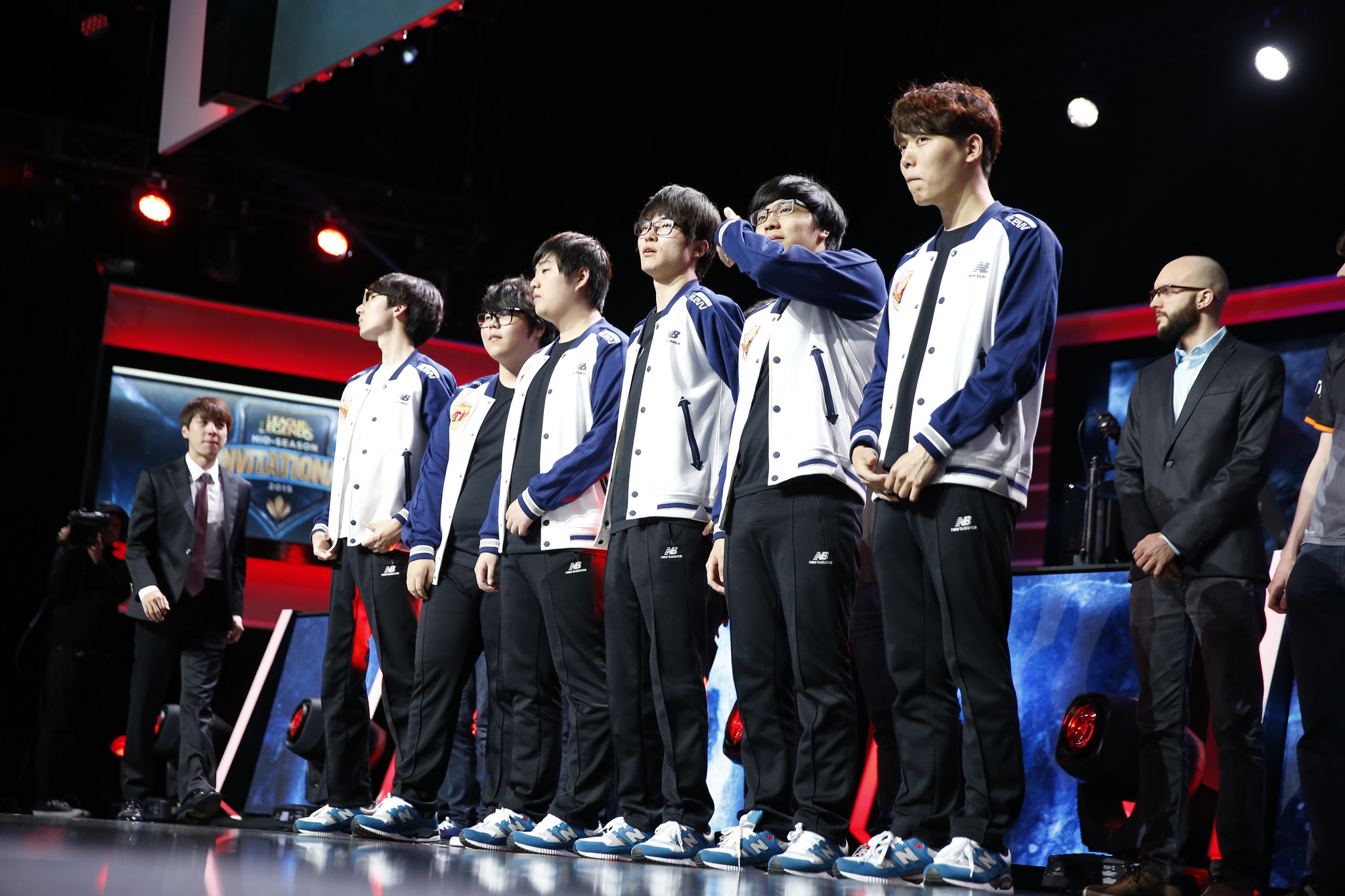Esports aren't a ticket to mainstream acceptance of gaming

There are hundreds of TV stations in Seoul and one of them is devoted entirely to fishing, but it’s still strange to flick through them and come across two channels of esports. You thumb past a K-pop video and an episode of Vampire Prosecutor1 and suddenly your TV screen is full of League of Legends or StarCraft II or FIFA. It’s especially odd watching FIFA since more recent games in the series have become so similar to actual televised soccer that there’s a second of confusion where you think the new season’s players have even more terrible haircuts than usual before you realize they’re digital.
The steps that lead South Korea to have this level of acceptance for competitive gaming read like something out of an alternate history novel. While early consoles were widely available there, sometimes thanks to local manufacturers creating clones of them2, in the 1990s the games themselves became more restricted. While violent PC games were sometimes censored—even StarCraft had to be modified and sold in two different versions, one rated Teen and the other Adult—console games were hit harder. Not because they were more violent, but because they were more Japanese. In 1994 the Korean government banned mass media from using the Japanese language, and the delay caused by localizing massive JRPGs meant they were beaten to the market by pirate copies and illegal imports. They were the most popular genre of console game in South Korea, and yet it wasn’t worthwhile selling them there3.
Where consoles struggled, PCs caught up the slack. They were helped by the South Korean government’s massive investment in telecommunications and internet infrastructure. The country now has some of the fastest internet in the world, making online gaming an attractive lag-free proposition even in its infancy. And those esports channels wouldn’t exist if it weren’t so cheap to get a TV station up and running in Seoul. Now Korea has esports arenas and prizes valued in the millions, but even so the audience is still mostly casual, switching loyalties from team to team as their fortunes change. It’s a large niche, but it’s still a niche, and nothing compared to the audience for mukbang, for instance—videos of people eating, which are massively popular on streaming service AfreecaTV and earn a living for some of the people making them4.
Competitive gaming is a large niche, but it’s still a niche, and nothing compared to the audience for mukbang.
While esports is a bigger deal in South Korea than it is in the west, it hasn’t resulted in the paradise of mainstream acceptance for video games outsiders assume it has. Education is incredibly important in Korean culture—another reason the PC is so prominent, as you can pretend it’s totally being used for homework, Dad—and gaming is seen as an impediment to young people’s study habits. The Youth Protection Revision bill, passed in 2011, bans players under 16 from online games between midnight and 6.00am. It’s colloquially known as the Cinderella law, and its purpose is to prevent kids from neglecting schoolwork because they’re up all night playing MapleStory or World of Warcraft5. Even though the Ministry of Culture, Sports and Tourism created an organizational body called KeSPA, the Korean e-Sports Association, gaming remains as mistrusted by the government and media as it is anywhere else.
On Twitch, where the audience is made of people who are already video game fans, League of Legends is the most-watched game. But on YouTube, with its much a broader audience, League of Legends is number five. Number one by a gigantic margin is Minecraft. According to Octoly’s figures there were 3,900 million views of Minecraft videos on YouTube in April. Number two on the list, Grand Theft Auto, had 1,390 million monthly views. It’s not hard to see why the YouTube audience watches Minecraft in overwhelming preference to other video games. They don’t watch it for competition, but it to see people playing the same way they do, experimenting with mods and co-operating to build amazing, extravagant things. The feats of exceptionalism they’re interested in are when someone builds Minas Tirith or the Starship Enterprise or all of Westeros.
'Video games are like sports' can be a useful analogy for explaining our hobby to people who don’t play games, but in the long run it does a poor job demonstrating why games matter. It’s the games you can’t really compare to something that already exists that can convince people to take them seriously. When parents worry about what their kids are playing, when governments change their mind about censoring games again, when the media ham-fistedly covers the latest controversy, the competitive side of games won’t convince them to take a more serious look. Showing them the cooperation required to work together with a group of friends to make castles in the sky is both more honest to the average person’s experience of games and more likely to win them over.
The biggest gaming news, reviews and hardware deals
Keep up to date with the most important stories and the best deals, as picked by the PC Gamer team.
Personally I’d rather be watching the K-pop channel than Minecraft, though. At least until someone uses that game to create mermaids being turned into sushi or post-apocalyptic warlords in outfits this fabulous.
1It’s about a prosecutor who is a vampire, not a human who prosecutes vampires. That would just be silly.
2In the Yongsan Electronics Market there’s a place called Video Game Alley where I found a Samsung Gam*Boy for sale, Korea’s equivalent of the Sega Master System. Samsung followed the Gam*Boy with the Super Gam*Boy, which ran Genesis games, though it was later renamed the Alladin Boy after the popular game based on the movie.
3This was exacerbated by worries about the potential for games to cause epileptic fits in children. Remember the mass hysteria over ‘Pokemon Shock’ when an episode of the anime was blamed for Japanese children suffering fits? A similar outcry occurred in South Korea when a boy experienced a fit while playing Street Fighter II, and again it was primarily Japanese games and consoles that lost sales because of parental concern.
4Mukbangs or “eating broadcasts” are livestreams in which someone eats a large meal in front of a camera while interacting with viewers via chat. Mukbangs are incredibly popular and their hosts, or Broadcast Jockeys (yes, BJs for short), receive fan donations that can add up to a lot. In Korean culture meals are traditionally a social activity and it’s often difficult to order food for one in a restaurant because everything is served with the expectation of communal eating. Modern lifestyles and work habits results in a lot more people eating at home alone and so the mukbangs restore a sense of the social to dinnertime.
5To sign up for online games in South Korea you need to provide a Korean Social Identity Number and phone number so that your age can be verified. Punishments for getting around the system, say by using your parents’ ID without permission or buying one from the thriving black market, can result in up to two years’ imprisonment and a $9,000 fine.

Jody's first computer was a Commodore 64, so he remembers having to use a code wheel to play Pool of Radiance. A former music journalist who interviewed everyone from Giorgio Moroder to Trent Reznor, Jody also co-hosted Australia's first radio show about videogames, Zed Games. He's written for Rock Paper Shotgun, The Big Issue, GamesRadar, Zam, Glixel, Five Out of Ten Magazine, and Playboy.com, whose cheques with the bunny logo made for fun conversations at the bank. Jody's first article for PC Gamer was about the audio of Alien Isolation, published in 2015, and since then he's written about why Silent Hill belongs on PC, why Recettear: An Item Shop's Tale is the best fantasy shopkeeper tycoon game, and how weird Lost Ark can get. Jody edited PC Gamer Indie from 2017 to 2018, and he eventually lived up to his promise to play every Warhammer videogame.

